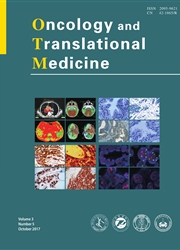

 中文摘要:
中文摘要:
这研究的目的是证实可再现的二维的 electrophoretic 试金使用了介绍和差别的鉴定的目的在人的舞台表示了蛋白质我肺腺癌和配对的正常肿瘤邻近的织物。从 12 人的蛋白质上演的方法我肺腺癌纸巾和正常肿瘤邻近的纸巾用等电位的集中的电气泳动(第一种尺寸) 和随后的同类的 SDS-polyacrylamide 胶化电气泳动(SDS 页)( 第二种尺寸) 被分开。差别表示了蛋白质用 PDQuest 图象分析软件被决定,并且用飞行团 spectrometry (MALDI-TOF-MS ) 并且数据库寻找的帮助矩阵的激光解吸附作用 / 电离时间识别了。人的井可再现的 2-DE 胶化模式上演的结果我肺腺癌和正常肿瘤邻近的纸巾被介绍, 26 差别表示了蛋白质揭开。这 26 个蛋白质点中的九个从准备胶化被切掉并且与 MALDI-TOF-MS 决定了。对蛋白质数据库寻找,四候选人蛋白质被识别。他们是 60S 酸的 ribosomal 蛋白质 P2,组织蛋白酶 B1, Apolipoprotein A-I 先锋,和 La 4.1 蛋白质。在这研究的结论,人的舞台的高可再现的 2-DE 胶化蛋白质图象我肺腺癌和配对的正常肿瘤邻近的纸巾成功地被完成,并且 4 差别表示了蛋白质被揭示。这些数据将对早简历标记的屏幕和人的肺腺癌的分子的机制的学习有用。
 英文摘要:
英文摘要:
Objective: The aim of this study was to establish reproducible two-dimensional electrophoretic assay used for profiling and identification of differentially expressed proteins in human stage I lung adenocarcinoma and paired normal tumor-adjacent tissue. Methods: The proteins from 12 human stage I lung adenocarcinoma tissues and normal tumor-adjacent tissues were separated using isoelectric focusing electrophoresis (the first dimension) and the subsequent homogeneous SDS-polyacrylamide gel electrophoresis (SDS-PAGE) (the second dimension). The differentially expressed proteins were determined with PDQuest image analysis software, and identified using matrix-assisted laser desorption/ionization time of flight mass spectrometry (MALDI-TOF-MS) and database searching. Results: The well-reproducible 2-DE gel patterns of human stage I lung adenocarcinoma and normal tumor-adjacent tissues were profiled and 26 differentially expressed proteins uncovered. Nine of these 26 protein spots were cut out from the preparation gels and determined with MALDI-TOF-MS. Searching against the protein database, four candidate proteins were identified. They were 60S acidic ribosomal protein P2, Cathepsin B1, Apolipoprotein A-I precursor, and La 4.1 protein. Conclusion: In this study, high reproducible 2-DE gel protein images of human stage I lung adenocarcinoma and paired normal tumor-adjacent tissues were achieved successfully, and 4 differentially expressed proteins were revealed. These data will be helpful for screen of early biomarker and study of molecular mechanisms of human lung adenocarcinoma.
 同期刊论文项目
同期刊论文项目
 同项目期刊论文
同项目期刊论文
 期刊信息
期刊信息
